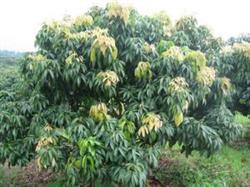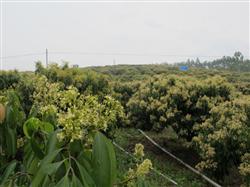Technical measures for flower and fruit protection of litchi

1. Strong flowers protect flowers. The main results are as follows: (1) applying strong flower fertilizer in time. Strong flower fertilizer is generally applied when the flower ear is drawn out to see the flower bud (also known as fertilization to see the flower). The amount of fertilizer application depends on the amount of flowers and tree potential, generally 50 kg of tree surface per fruit, 1 kg of compound fertilizer plus 0.2 kg of urea, or 0.5 kg of urea, calcium superphosphate and potassium chloride. In addition, spraying 0.3% potassium dihydrogen phosphate on leaves about 20 days before flowering, or Luwang 1 (high potassium) 1000 times plus 0.05% borax, can promote flower ear development. (2) reasonable panicle control. The production practice shows that the flower quality of early and over-long flower spikes is poor, the proportion of female flowers is small, and the fruit setting rate is low, especially for the varieties with large flower spikes (such as Feizixiao), the flower quantity and flower quantity should be adjusted and controlled reasonably in order to improve the fruit setting rate. ① truncated the spike artificially. Truncated spikes can reduce the number of flowers and improve the quality of flowers. The weight of the short spike depends on the variety, and the varieties that have strong ability to regenerate and are easy to draw secondary spikes, such as Feizixiao and March Red, can be heavier. The drugs used for panicle control by ② include litchi high yield hormone, ethephon and so on. (4) Control of diseases and insect pests. The main diseases and pests harmful to litchi flower and ear are litchi bugs, litchi gall mites, inchworm, aphids and litchi downy Phytophthora. It can be controlled by Lexben, propargite, imidacloprid, methamphetamine, trichlorfon, aphid like, Ruidu manganic zinc, disinfectant alum, Dasheng Mrel 45, metalaxyl and other drugs. 2. Strengthen the management of flowering stage and improve the rate of fruit setting. The main points are as follows: (1) release bees for pollination. It is generally required to keep a box of bees every 3 to 5 mu. (2) artificial assisted pollination. The commonly used method of artificial pollination is to gently shake the newly opened male flower ear with a wet towel to collect pollen, and then put the towel in clean water for many times to make the pollen suspension a yellowish turbid liquid, that is, spray it on the female flower. Matters needing attention for artificial pollination: first, the sunny day with the temperature above 16 ℃ should be selected; second, the pollen liquid should not be placed for more than 20 minutes, otherwise the pollen will lose its vitality and affect the pollination effect. (3) spray water to prevent baking flowers in dry days. (4) shaking trees to prevent retting flowers in rainy days. 3. Protect the fruit and strengthen the fruit. The main results are as follows: (1) fertilizing strong fruit to protect fruit. Litchi flowering consumes a lot of nutrients. In order to ensure the nutrients needed for fruit growth and development, it is necessary to apply strong fruit fertilizer in time from flowering to the size of young fruit and mung bean. The amount of fertilizer application should be determined according to the tree potential and fruit, at the same time, attention should be paid to extra-root topdressing. (2) ring cutting to protect fruit. For the strong-growing trees, the female flowers began to be cut 10-15 days after flowering, on a big branch 4-6 cm thick, cutting once, down to the xylem. The weak tree is not cut. (3) using plant growth regulator to protect fruit. Use 20 mg / L gibberellin to protect the fruit when the fruit is big. (4) strengthen water management to protect fruit. Water should be irrigated during drought, spray water on the canopy when high temperature and strong sunshine, and drain water in time when there is too much water in the rain. (5) timely prevention and control of diseases and insect pests to protect fruit. The main diseases in litchi fruit development period are litchi downy blight, litchi soot, litchi anthracnose, and the main pests are litchi stem borer, litchi bugs, litchi small gray butterfly and so on. Emphasis should be placed on the prevention and control of diseases and insect pests in the young fruit stage of litchi.
- Prev

Management measures of Litchi in Spring
The climate is generally dry in China, which can promote the nutrition accumulation and flower bud differentiation of litchi and longan. At present, it is spring, and the management of litchi in this season is related to the key link of the growth and development of that year. According to the current growth and development of litchi and longan, the following suggestions on spring tube technology are put forward. Litchi is made up of.
- Next

Technical measures for flower and fruit protection of litchi
1. Strong flowers and flower protection. (1) Timely application of strong flower fertilizer. Strong flower fertilizer is generally applied when flower buds are seen (also known as flower fertilization). Fertilization depends on the amount of flowers and tree vigor, generally 50 kg per fruit tree surface, apply 1 kg compound fertilizer plus urea 0.2~0.5 kg, or urea, calcium superphosphate, potassium chloride each 0...
Related
- Moge, come on! The staff of the peasant association in the producing area of cantaloupe were frightened when the crowd gathered.
- Causes and Solutions of low Fruit setting rate of Apple
- Symptoms and control measures of passion fruit virus disease
- Fruit growing lesson: how do apple orchards keep high yields?
- Can you build orchards in the mountains? What are the pros and cons?
- How to manage the coloring period of Crisson grape?
- This paper introduces the processing technology of two kinds of fig products.
- How much is a month for retired teachers in rural areas by 2020?
- How can strawberry planting increase sugar content? We should pay attention to management in many aspects.
- What are the cultivation techniques on how to improve the yield of golden fruit?

